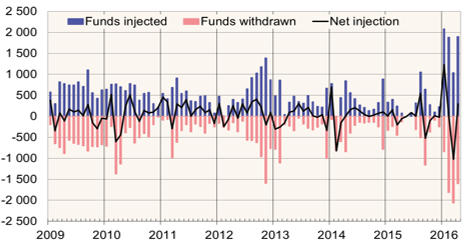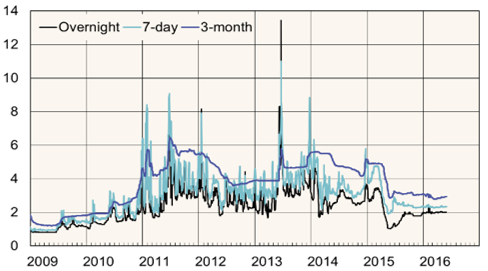BOFIT Weekly Review 22/2016
People’s Bank of China increases open market operations as monetary policy seeks new direction
Since Chinese New Year ended in February, the People’s Bank of China has engaged in open market operations on a daily basis. Previously, it had conducted them twice a week. The volume of open market operations has also increased. In recent months, the instrument of choice has been the reverse repo (buying debt securities from banks with agreement to sell them back). The impacts of the PBoC’s monetary policy measures are apparent in the interbank money markets, where both repo and Shibor rates have remained steady since last summer.
Monthly volume of PBoC market operations (CNY billion)

Source: CEIC
The PBoC has also sought to boost liquidity through various lending programmes. Under the medium-term lending facility (MLF), the central bank offers commercial banks 3–12-month secured financing. Some 1.74 trillion yuan was lent under the MLF during January-April, while MLF repayments amounted to 910 billion yuan. The PBoC channelled 310 billion yuan to the country’s policy banks under its pledged supplementary lending (PSL) programme in January-April. The combined lending stock of the two programmes amounted to 2.9 trillion yuan (€400 billion) at the end of April. This year short-term (1–7 day) market liquidity has been boosted through the PBoC’s standing lending facility (SLF). Interest rates under PSL, MLF and SLF programmes have also been reduced. For example, the interest rate on a 3-month MLF loan in April was 2.75 % p.a.
Since the deregulation of interest rates last autumn, the Chinese monetary policy measures and its direction have become harder to deduce. The most important monetary policy tool of the moment seems to be the reserve requirement ratios (RRRs) for banks, which the PBoC employs e.g. to provide lending guidance and as a macroprudential tool. The RRRs for individual banks, however, may differ from the general level of the banking sector. Recently the PBoC seems to have been cautious in relaxing of the monetary stance through lowering of RRRs and reference rates, which are closely followed by the markets. Broad-based policy easing could stoke capital outflows from the country and add to yuan depreciation pressures. The central bank has eased domestic financial conditions mainly through focused measures.
Shibor interbank market rates (% p.a.)

Source: Macrobond